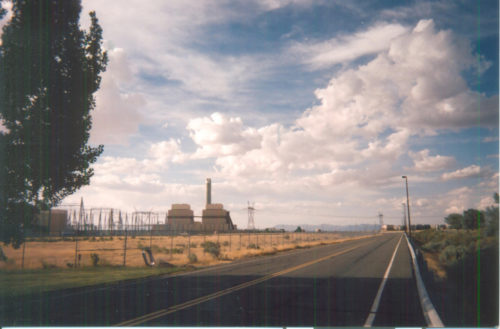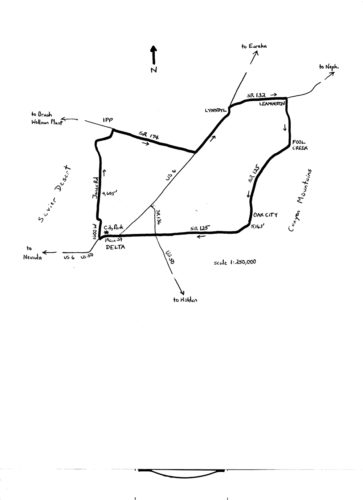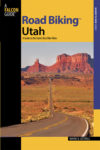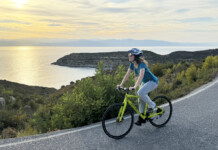
Wayne Cottrell
By Wayne Cottrell
The Delta Dunes Cruise is a 56.9-mile loop through desert communities of northeastern Millard County, starting and finishing in Delta. The city of Delta is located 133 miles to the southwest of Salt Lake City, in the vast Sevier Desert. Delta is a gateway city to the Great Basin Desert, being the last point of urbanization for about 150 miles when heading west. Delta and the surrounding communities had a population of about 4,800 in 2013, representing just under 40% of Millard County’s total. Although Delta’s surroundings can appear as dry, arid and barren, the economy is actually heavily based on the flowing waters of the Sevier River. Irrigation from the river enables an abundance of agriculture, including dairy products, in the region. The river tends to run dry to the south of Delta, though, in part because of its use in the fields, but also because of upstream damming. The DMAD (Deseret, Melville, Abraham and Delta) project stores some of the water in a reservoir, and diverts some to the IPP. The latter, the Intermountain Power Project, a coal-fired power plant, supplies nearly all of the electricity for Los Angeles County, California.
You can generate your own power in this bike ride, perhaps enough to light up one of the smaller communities in the Sevier. Although the ride passes through several towns along the way, at which you can stop to reload on fluids and refreshment, be sure to carry plenty with you for the long stretches in between. Start the ride at City Park, located in the heart of Delta, along Main Street. Head west from 200 West, on Main Street. Wake your legs up with a brisk climb and descent over the railroad tracks that border the city. You are now on double-signed U.S. Routes 6 and 50, leaving Delta. Turn right onto 1000 West at the 0.9-mile mark of the ride and head north. There are a few industrial uses out here, but the land is predominantly agricultural for the next few miles. 1000 West curves to left at mile 2.4, becoming 1500 North. Turn right at North Jones Road (mile 2.7), and continue heading north. Standing like a sentinel in the desert, well off in the distance, is the Intermountain Power Project (IPP). It is nine miles away, but looks closer than it actually is. The Sevier River snakes through the wetlands region off to your right; you may be able to catch a glimpse of it, although there really is no “high ground” out here. The low elevation of the ride (4,605 feet) is reached as you head north on Jones. About ten miles to the west of here is the abandoned community of Topaz, which served as an internment camp for Japanese-Americans during World War II. The camp’s population reached a peak of 8,255 during that time, making Topaz the fifth-largest settlement in Utah. About two-thirds of the internees were actually U.S. citizens. The Central Utah Relocation Center, as it is now called, is on the National Register of Historic Places.
The massive IPP is at the junction of Jones and State Route (SR) 174, at mile 11.6. Turn right here, and head east southeast. SR 174 is also known as Brush-Wellman Road, in reference to one of Delta’s other chief economic activities: mining. The Brush-Wellman Plant, where beryllium is extracted from ore, is actually located well west of here. For good reason: beryllium is highly toxic! Continue heading along the straight-as-an-arrow SR 174; notice the sand dunes to your left and right. SR 174 climbs very gradually to a junction with U.S. 6 (elevation 4,790 feet). There is a railroad crossing just before the junction. Turn left onto U.S. 6, now at mile 19.7, and head northeast. Enter the town of Lynndyl at mile 24.4. This town had a population of 110 in 2013, reflecting an 18% loss since 2000. The town was named after the city of Lynn, Massachusetts (true!). Turn right onto SR 132 at mile 25.7 and head east. The highway descends gradually into a valley corridor, with railroad tracks on your left, and the Sevier River coming up from your right. Enter the town of Leamington at mile 29.4. The population of 227 in 2012 was down 36% from its 1930s-era peak of 356. Turn right onto SR 125 at mile 30.65 and head south. The Canyon Mountains are to your left. At the aptly-named Cemetery Lane, the highway starts the only truly significant climb of the entire ride: a 4.2% grade for the next 1.75 miles, taking you up to 4,933 feet. After plateauing for about two miles, the climb continues, breaking the 5,000-foot elevation mark for the first time, as you enter the community of Fool Creek at mile 35.1. The story behind the name is that pioneers entered the area, excited to find water flowing in the creek. The pioneers enthusiastically returned with their families, only to find that the creek had run dry.

After leveling off again, SR 125 begins a gradual climb into Oak City. This city had a population of 592 in 2013, down 9% from 2000. Oak City was the nation’s first choice for an atomic weapons laboratory during the 1940s, at which the first A-bomb would be built. Dr. J. Robert Oppenheimer, the director of the Manhattan Project, overruled the choice, however, preferring Los Alamos, New Mexico. While pondering what might have been as you pedal on through, perhaps it is fitting that the high elevation of the ride is reached here (5,163 feet, at mile 43.8). Stay on SR 125 as it curves to the right to head west. From here, it is literally a straight shot back to Delta, over a long, gradual descent of just over 500 feet. Keep straight onto U.S. 50 at the junction at mile 52.5. Enter Delta at mile 55.3; keep straight at the junction with U.S. 6 at mile 56.1, continuing onto Main Street. Watch out for motor vehicle turning movements at this tricky intersection. The ride ends at 200 West, at City Park, at mile 56.9.
Start/finish coordinates: 39.352519oN 112.579233oW
For more rides, see Road Biking Utah (Falcon Guides), written by avid cyclist Wayne Cottrell. Road Biking Utah features descriptions of 40 road bike rides in Utah. The ride lengths range from 14 to 106 miles, and the book’s coverage is statewide: from Wendover to Vernal, and from Bear Lake to St. George to Bluff. Each ride description features information about the suggested start-finish location, length, mileposts, terrain, traffic conditions and, most importantly, sights. The text is rich in detail about each route, including history, folklore, flora, fauna and, of course, scenery.

Wayne Cottrell is a former Utah resident who conducted extensive research while living here – and even after moving – to develop the content for the book.






